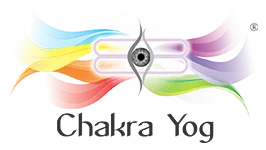Planets for Anahata Chakra

According to historical astrological tradition, the classical seven chakras of the human body have been related to the seven classic planets for millennia, and according to Vedic astrology, the nine planets have a connection with the major eight chakras. Even more planets are linked to the chakras in modern Western astrology, including those discovered in contemporary history. As a result, there is a long legacy of connection between the planets and the chakras in all astrological systems and traditions across the world.
Planets in a birth chart represent the baby’s potential qualities and energies, and our chakra system is made up of many latent qualities and energy centers that have been linked to planets since antiquity. Since ancient times, the planets visible to the naked eye in our solar system have been regarded as gods, ruling over human affairs ranging from medicine to politics and all aspects of people’s lives. It is not surprising then that they are linked to various body systems. In Western astrology, they are linked to various organs and functions of the body, and in Vedic astrology, they are similarly linked to our chakras.
This long-held link is now explained by modern science so that we are made up of the same elements as the planets. They are no distant objects in the sky with no connection to human life, but as astrological research has revealed, they are indicators of inner motivations and energies and their dynamics in our lives, qualities, and attributes, just in the same way our dynamic energy vortexes (chakras) work in our bodies too. Therefore, rather than a link between planets and chakras, we can refer to it as a similarity in principles, energies, and patterns.
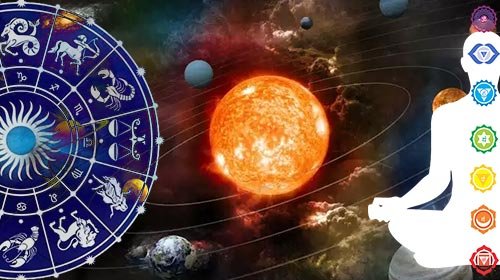
Planetary remedies have long been used by Vedic astrology to help balance our chakras because each dynamism both above and below (sky and earth) are intrinsically connected and show up in our birth chart. Religious rituals are performed in Hinduism to appease these dynamic forces or energies, which are linked to gods and goddesses ruled by these planets so that they can be integrated into our lives in congruence. Similarly, in Western astrology, the mythology of the gods and goddesses associated with the planets is linked to depict the significance and attributes of each planet and their respective energies.
For the first time in recorded history, scientific astrological research in the last century (Gauquelin et al.) demonstrates the validity of astrological pointers in sketching the personal traits of a person. Similarly, it has long been established that the balance or imbalance of our chakras derives from various traits and outcomes in the lives of individuals. In both cases, there is solid enough scientific background to work with both components (chakras and planets) in combination.
Having said that, there are several methods for balancing our energy vortexes (chakras) by paying attention to the corresponding energy patterns (planets). The western astrologer will analyze the condition of the planet associated with the chakra in the birth chart to determine how to balance its natural energies in such a way that the related chakra energy is restored. By analyzing the chakras and their ruling planet, one may determine the source of one’s life’s highs and lows.
On the other hand, the Vedic astrologer will prescribe religious remedies such as planetary pujas to the different Hindu deities associated with each planet in order to appease these energies and, in the same way, bring these forces into harmony so that they can be favorable for the native rather than a hurdle on the path with the clearance of any chakra imbalance related to the associated planet and deity.
The analysis of the natal chart to determine how these planets are placed and combined is common in both systems (vedic and western) so that any imbalance in the chart can be corrected accordingly using the methods described above. Being aware of the nature and qualities of the planets associated with the chakras, as well as cultivating these qualities in ourselves in their positive manifestation, helps to bring our chakras into balance. For this, we must first look which planets are linked with their related chakras and what their symbolism involves.
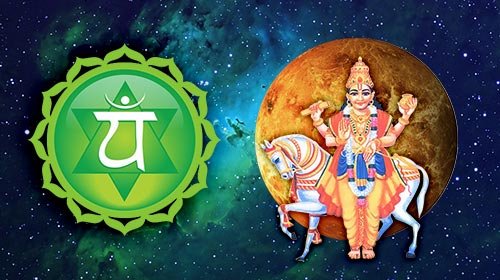
Venus is the planet of Love, manifestation and relationships, and it is connected to both Anahata and the Sacred Heart (Hrit Padma) chakras. In Vedic astrology it is referred to as Shukra, a Sanskrit word that translates to “clear” or “bright.”
Since ancient times and throughout all astrological systems and traditions, Venus has been worshiped as the beautiful goddess of love. Venusian characteristics include femaleness, gentleness, love, diplomacy, art, creativity, and sensitivity. Venus governs the feminine side of the human mind just as Mars governs the masculine side. ‘What Venus desires, Mars obtains (for her),’ according to an old astrological saying. This brings us to the subject of relationships, which is ruled by Venus, a planet with a special affinity for close interactions and relationships, including marriage.
Our ability to enjoy life and be happy is surprisingly determined by our intrinsic nature rather than our life experiences or circumstances. The Venus principle reveals a lot about our ability to appreciate beauty, both in the outside world and within ourselves. Venus represents where and how we get affection in life, as well as, to a large extent, what we enjoy doing. A well-placed Venus in the natal will help us to accept what others have given us and the cards that life has dealt us. A balanced Venus fosters a sense of trust in life, allowing us to manifest our desires with ease and the winds to blow in our favor in relationships. However, when this planet is afflicted in our birth chart, the opposite may occur. The astrologer can predict how Venus’s position in the chart will impact partnerships and whether or not they will be easy to form.
Venus reminds us that none of us live alone: we all need others to survive and share with them all that life has to offer. When this truth is realized as we grow up we start to show more acceptance for others and life as they come and the lower emotions like anger, expectations or mistrust begins to vanish. Venus rules everything pleasant, lovely, delightful, elegant, and appealing, aside from relationships and love. The position of Venus in the chart also indicates the area of life in which we prefer to pamper ourselves or others, as well as how we give and accept affection from others. This placement will also demonstrate how we go out of our way to make people happy. As a result, Venus represents not just the female spirit, but also enjoyment, pleasure, happiness, and love.
Our natal Venus describes those attributes that others find attractive or admirable about us, usually without any effort by our part. Birds sing and other animals make noises to attract a mate (Venus is co-significator of music); other species uses other attributes such as size, color or pheromones to attract. Venus shows our own particular human equivalent of birdsong or plumage. And in the same way that Venus shows how we attract others, the planet has rulership over magnetism in a physical sense, too. Venus concerns itself with the principle of attraction, and therefore, it also describes, what we are attracted to.
Venus is also known as the cosmic peacemaker. The astrological Venus points out the urge for harmony and peace and our ability (or not) to achieve this. In Venus mode we find points of agreement and similarity, in this mode we are ready to give in. In this mode we want to equalize and balance and are willing to yield. There is an urge to reciprocate and co-operate with others. Actually, the principle of co-operation is also key to the planet and also to the success of all relationships. Moreover, greater potential for peace comes with equality as, arguably, so does happiness.
Being the planet of love and relationships, Venus has a civilizing effect. The more civilized an individual or a society is, the less likely they are to engage in war or other kinds of dispute. Manners and courtesy are distinctly Venusian attributes and are characteristic of civilized behavior. The need to be liked and loved civilizes people by knocking off the raw edges in their behavior. Coarse and discourteous behavior is decidedly anti-Venusian. Polite, civil behavior increases good feelings between people, minimizes discord and maximizes the chances for agreements to be made.
Venus says much also about our values and therefore can also be associated with money. What we find beautiful, or for some other reason value highly, we will be willing to pay for. When we are in love, we value the other person and find them beautiful and enchanting, which leads to marriage where resources are shared for stability and sealing the bond. When we are well paid, we also feel valued and we tend to value ourselves more. A good placed Venus in the birth chart increases our ability to materialize everything we desire.
It is in the Hindu pantheon of gods and goddesses where we can find the probably best embodiment of Venusian energies, which is Goddess Lakshmi, the shakti or energy behind Lord Vishnu, the presiding deity of Anahata chakra.
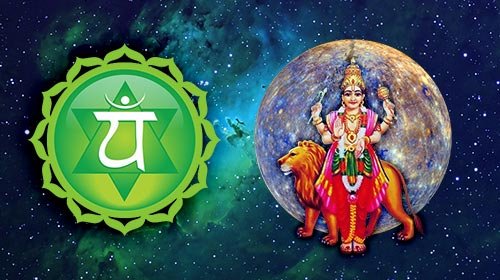
Another planet associated with the Anahata chakra is Mercury, which, like Venus, is associated with the Air element. Mercury plays a central role in relationships of all kinds for most problems in relationships start off as communication difficulties and Mercury is the planet of communication. The way messages are conveyed is crucial to the way in which they will be received. However, sometimes there is either an inability to communicate effectively or to listen or understand others.
Mercury’s position in our birth chart has a lot to do with all mental processes and how we digest and assimilate information. This is closely related to how we experience our relationships with others and the world, as well as how we process our perceptions and memories about them. Mercury, as the gods’ messenger, acts as a kind of switchboard in the psyche, delivering messages to various aspects of ourselves as well as messages from the various parts of ourselves to the outside world and those within.
As a result, Mercury is critical in maintaining harmonious understanding and relationships with ourselves, others, and the world around us. An afflicted Mercury usually manifests as a significant interference in all relationships, disrupting basic social blocks such as communication and understanding; therefore, when bringing the Heart (Anahata) chakra into balance, it is always important to consider how Mercury is placed in the natal chart.
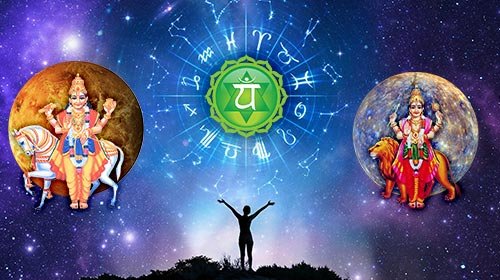
As we have seen a healthy chakra functioning in a balanced way indicates we have our planetary energies working productively for our development, and vice versa: an unfavorable positioned Venus or Mercury leads to an imbalanced Anahata.
We at Rudra Centre offer expert Vedic astrological advice to help you balance your Anahata chakra for a successful living. Our expert astrologers and pandits are experienced in performing the right rituals and recommending the right remedies to restore balance to your Heart (Anahata) Chakra.
Additionally, we have a wide range of yantras and Rudraksha beads strung by the prestigious Rudraksha Ratna Science Therapy ® to assist, speed and sustain the complete healing process. Please don’t hesitate in contacting us for professional help in balancing your Anahata chakra anytime.


